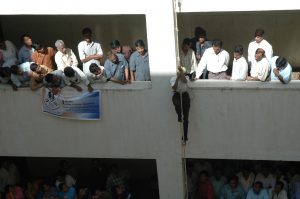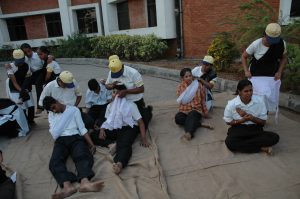The highest rung of the Disaster management training ladder is the Advance Training Course. This course further cements the foundations laid in the seven day basic program. The course also sharpens the ability to make decision accurately.
The response under extreme pressure of limited time is the essence of this advanced AADM training. This advanced training course also strengthens the team work skills of the participants. In a way this advanced training thus focuses on training the participants in all the aspects, data requisites to appropriately respond to a disaster scenario and on the practical usages of the methods taught.

AADM advanced rescue demonstration
Course Objectives
The Advance course curriculum covers the following aspects:
- Imparts knowledge, skills and attitudes to handle various types of disasters
- Provides practice platforms for numerous situations in which one has to apply all that is imbibed during the program
- Simulates realistic environments of earthquakes, floods, fire etc so that the DMVs get familiar and do not panic when such contingencies actually occur in real time

AADM advance Rescue Training
- Engrosses the participants in the virtual exercises so that his body and mind are familiar with the physical, mental and emotional states that could be encountered during the actual calamity
Scope and Opportunities
- An AADM certified participant can take part in the activities organized by the other wings of the institution
- A trained participant can also be a part of the AADM team that is invited by municipal and other official authorities
- The course allows for becoming an instructor in the Academy
- It enables one to contribute to the safety of the self and society at large
- Recognition in professional circles for the certificate that is obtained on successful completion of course
Course Duration
AADM Advance course is conducted over 8 Sundays. Each day has a 3-4 hour session
Course Framework / Outline
The advanced training focuses mainly on the practice and usages of the methods learned during the basic course.
Some of the topics that are covered in Advance Training are as follows:
- Importance and elements of a First Aid Kit
- Information of creating DMV’s active communication chain
- Focusing on team work and formation of different teams viz. search team, rescue team, crowd control team etc.
- Taking stock of the given situation before planning and execution
- Training in how to rescue people from debris
- Rescue techniques to be adopted in case of fire
- Learning to tie different kind of safety knots and creating rope ladders
- Rescue sliding and escape methods with special focus on dealing strategies for senior citizens, the disabled and infants
- To understand the psychology of the patient
- Practice in controlling crowds and ensuring co-ordination between the rescue groups.
DAY 01
Technical Analysis (Survey and Design)
This includes showcasing of techniques and equipments required to survey the disaster struck area
This also includes collecting basic emergency information like important addresses and telephone numbers in the surrounding areas for e.g 24-hr medical shops, police station, and fire brigade etc.
DAY 02
Technical Analysis (Electrical, Mechanical, Telecommunications)
The participants have an option to choose a topic from the above three as per their interest and aptitude. Now the survey is made more specific and DMV-groups work in their respective fields (e.g. Electrical group surveys the surrounding area and checks for any alternative source of energy, mechanical group surveys the area and looks out for raising some temporary structure to move the causalities, telecomm group searches and makes available any alternative source of communication
DAY 03
Medical and Paramedical staff
This covers the necessary medical and paramedical training of the DMV staff. It also covers various ways in which other DMVs can help the medical / paramedical staff.
DAY 04
Rapid Rescue Force
Focuses on techniques to reach the disaster site immediately, practicing the most effective rescue techniques and also other techniques like fire fighting, rappelling etc.
DAY 05
Rapid Rescue Force
Necessity First Aid Kit
DMV’s active communication chain
Necessity of Control room to guide, direct and unite each DMV
DAY 06
Logistics
There are two types:
Manpower Management: To keep a track of total no of DMV’s and duties assigned to them
Material / Equipment management: To take a stock of available equipments and to assess additional requirement if any to support the rescue operation
DAY 07
Transportation Management: Transportation of DMVs to the disaster site, transportation of causalities away from the disaster site, admitting them to the hospital etc.
DAY 08
Evaluation and Assessment
The training program gives equal importance to the practical aspect of the program too
Infrastructure Requirement
The Advance course is conducted where both a closed and open space is available for the relevant sessions
Course Faculty – Teaching and Support
All the instructors of the Advance course have successfully cleared their basic course as well as Advance training program of the Academy. Moreover care is also taken by AADM to select active volunteers who have mastered the Rescue operations and are regular members or supervisors of the Rescue team.
Participant Eligibility Criteria
- Age: 18 yrs and above
- Applicant should have completed the Basic training course of AADM
- Applicant must be a regular member of the rescue practice team
- The person should be physically and mentally fit
Evaluation and Assessment
- The participant evaluation consists of written, oral as well as practical examinations
- The duration for the written and oral exams is 1 hour each
- The practical exams are conducted in groups
